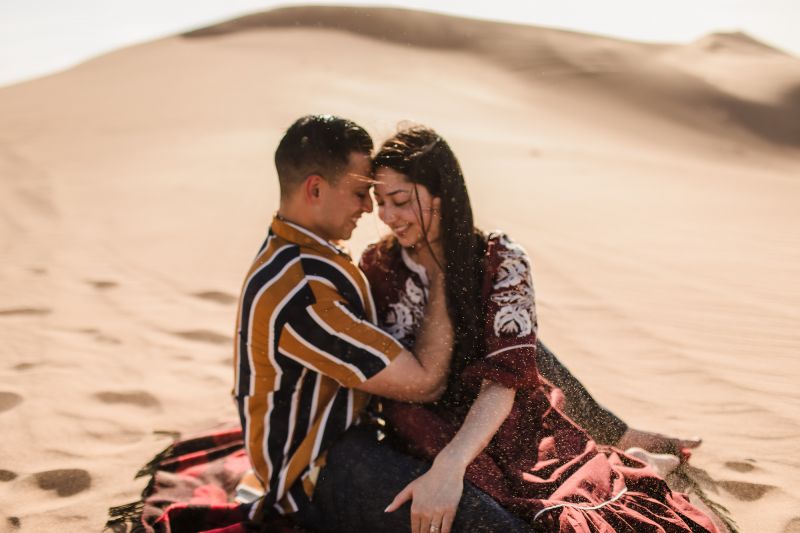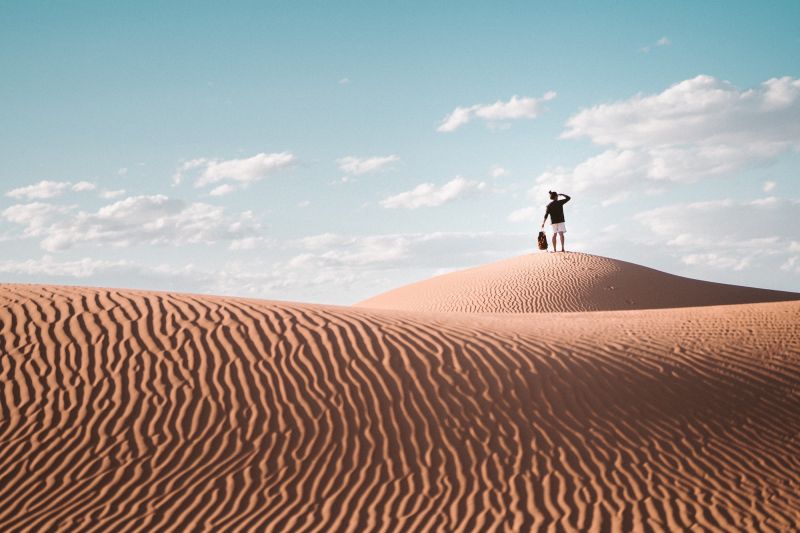
When properly executed, desert photography can produce some truly gorgeous results. The patterns, colors, and forms of desert landscapes lend themselves well to the art of photography. In order to make the most out of your next trip to the desert, however, you should follow some basic guidelines. That said, here are eight desert photography tips that can help you fully capture the landscape’s beauty.
This article will cover all types of desert photography. For more detailed information on desert portrait shoots, see our desert photoshoot article over on Wedding Maps.
Desert Photography Tips
- Understand the Different Types of Deserts.
- Make Sure you Prep for Tough Conditions
- Bring All the Essential Gear
- Choose the Right Lenses
- Fall Back on the Basics of Landscape Photography
- Seek Out Patterns
- Let the Sun Provide Low-Angle Lighting
- Capture the Full Colors of the Sunset
- Snap Breathtaking Silhouettes During Twilight
- Make Use of the Gorgeous Night Sky
Understand the Different Types of Deserts.
While there are many types of deserts from a scientific perspective, from a photographer’s perspective, there are three primary types of backdrops that you’ll encounter: 1) Deserts with sand dunes, 2) Deserts with plants and 3) Deserts with rock formations. See some of the examples below.
Deserts with Sand Dunes
Sand Dunes are the quintessential desert photo.

Deserts with Plants
The cacti and other drought tolerant plants in the desert are full of character, with spikes, textures and shapes not found anywhere else.

Deserts with Rock Formations
The rock formations in desert landscapes create beautiful backdrops for desert photography.


Make Sure You Prep for Tough Conditions

There’s a reason deserts have less life than more verdant regions. The dry conditions and the ceaseless sunlight make it tough for most organisms to get by, and humans are no exception. In order to cope, make sure you bring a hat, clothes that cover your skin, and a powerful sunblock. You should also consider planning your trip for the colder months of the year. A journey into the desert can be unpleasant and even dangerous during moments of extreme heat. Plenty of water is also a must in the desert no matter when you visit.
In addition, be prepared for unpredictable weather events such as sandstorms.

Bring All the Essential Gear

In addition to health and safety-related supplies, you also need to pack the photography equipment necessary for desert photography. A typical outing will require the following pieces of equipment:
- Lenses, from wide-angle to telephoto
- A tripod
- A lens pen for removing sand from cameras
- A lens cover
- Extra batteries
- An umbrella for the tripod during high winds
You might get away with missing some of this equipment, but you should try to bring as much of it as possible.
Choose the Right Lenses

While you should try to bring as many lenses as you can realistically carry, some are more important than others. A wide-angle lens is essential for capturing as much of the beauty in a single frame as possible. It will also allow you to show the full beauty of foreground details. A telephoto lens, meanwhile, is perfect for capturing beauty in the distance. A huge desert photography tip when selecting lenses is to identify your subject and choose a lens accordingly.
One important note is that you should try your best to avoid unnecessary lens changes in the desert, especially in deserts with fine grain sand. A little bit of bad luck with the wind and your camera body can get infiltrated by pesky sand that is hard to clean. If you have to choose, stick to a versatile focal length range such as 24-70mm.

Fall Back on the Basics of Landscape Photography

While a desert’s geography is certainly unique, you can still employ the basics of general landscape photography, especially when it comes to composition. A desert photography tip to keep in mind is to keep your eyes peeled for leading lines, interesting forms, and tidy framing possibilities. This should be easy given the number of fascinating objects present in a typical desert landscape. Lines are especially prevalent in arid climates, with sand, rocks, and cacti providing exciting composition opportunities.
Related Reading: Tips for Visiting and Photographing the Death Valley Super Bloom
In the following example, see how Tanya Parada utilizes negative space in her composition to illustrate vastness.

Seek Out Patterns

One of our favorite desert photography tips is to search for patterns in the sand to aid in your composition. Windswept sand, scraggly plants, and twisted rock formations can all boast unique and exciting patterns. Always be on the lookout for these when roaming the desert with your camera. Train your eye on what’s near and far, big and small. You might find a pattern on a tiny stone by your feet or a series of distant mountain peaks. Wherever they present themselves, patterns make for great photography.
Let the Sun Provide Low-Angle Lighting

Desert scenes often boast wonderful natural lighting. This is especially true in the winter when the sun is lower in the sky. Some of the most spectacular desert photographs are taken with the sun backlighting cacti or other plant life. Try visiting the desert in the morning or late afternoon, and always keep your eyes peeled for these ideal conditions.

Capture the Full Colors of the Sunset

The dry weather in the deserts are often accompanied by incredible oranges and reds in the sunset skies. Be prepared to capture these colors by utilizing the proper sunset photography techniques. In particular, watch your histogram to ensure that you aren’t blowing out any highlights or clipping any shadows. This will allow you bring back all of these colors in post production. We recommend using the HDR Natural Presets in the Visual Flow Preset packs.

Snap Breathtaking Silhouettes During Twilight and Sunset

The minutes immediately following sunset provide some of the best opportunities for sensational desert photography. Whatever you lose in color is easily made up for by the spectacular shading of desert silhouettes. From cacti to rock formations, all sorts of desert features look their best in profile before a darkened sky. If you arrive in the desert earlier in the day, make note of any arresting features while taking your daytime shots. Then, once the sun has begun setting, hurry back to these spots for remarkable twilight shooting.
See the sunset silhouette examples below.

Make Use of the Gorgeous Night Sky

As breathtaking as the desert can be during the day, some argue that it becomes even more beautiful at night. The unique forms and rugged beauty of a desert landscape provide ambitious photographers with a great opportunity to put their nocturnal skills to the test. To really capture the essence of the desert night sky, you’ll need a full-frame camera, a wide-angle lens, and a cable release so you can avoid touching the camera. With the right equipment and an appealing subject for the foreground, your nighttime desert photos could be the best shots of your entire trip.

What to Check Before Heading Out
Now that you know all of these helpful desert photography tips, it’s time to plan the photography trip of a lifetime. Here are some questions to ask yourself before heading out:
- Have I packed everything I need for the harsh desert conditions?
- Have I planned my trip for the right time of year?
- Have I made sure the weather forecast is okay?
- Have I checked for the possibility of dangerous sandstorms?
- Do I have all the equipment I need?
If you answered “yes” to all these questions, then it’s time to grab your camera and hit the desert.
Conclusion: Bringing Your Desert Photographs to the Next Level
The desert is one of the most breathtaking natural landscapes on the planet. With the necessary equipment and proper mindset, you should be able to capture some truly spectacular images. Keep these desert photography tips in mind as you plan and execute your trip.




Get Connected!